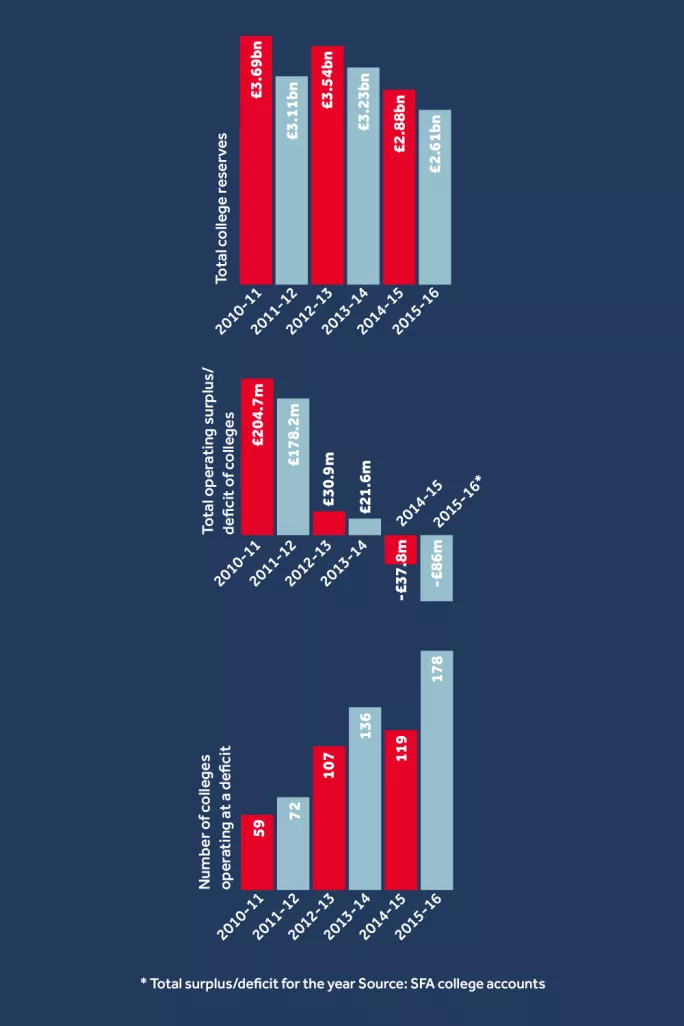Colleges ‘at risk of losing control’ as reserves fall

Financial reserves are the ultimate safety net by which colleges protect themselves against cash turmoil. Accumulated over many years, they can be used to cover one-off items of expenditure, such as large building projects. Colleges also use them, however, to safeguard against sudden and unpredictable changes within their environment, such as funding cuts, fluctuations in student numbers or urgent campus repairs.
But a new Tes analysis of college accounts reveals that £1 billion has disappeared from college accounts over the past five years. The total reserves held by colleges across England have decreased from £3.69 billion in 2010-11 to £2.61 billion in 2015-16. The trend broadly matches the drop in the overall core budget for adult skills, which fell from around £3 billion to £2 billion between 2009 and 2015.
This suggests that more colleges have dipped into their reserves to replace government funding. Julian Gravatt, deputy chief executive of the Association of Colleges, says that other factors leading to a reduction in colleges’ reserves could include changes in pension deficits and capital expenditure.
But a lower level of reserves is a concern, he adds: “That means there is a risk of colleges losing control. It is an unpredictable environment. There will be some colleges that have too many reserves, but it is unusual.”

‘Inadequate’ financial health
In 2015, the National Audit Office warned that the number of colleges under financial strain was expected to rise “rapidly”. The financial position of the sector had been declining since 2010-11, said an NAO report, which highlighted that the number of colleges assessed by the Skills Funding Agency to have “inadequate” financial health had risen from 12 in 2011 to 29 in 2015.
“The decline in the financial health of the sector has been quicker than indicated by colleges’ plans, and current forecasts suggest that the number of colleges under strain is set to rise rapidly,” the NAO concluded at the time. At present, 41 colleges are subject to a notice of concern over their financial health.
In 2015-16, Westminster Kingsway College had the biggest reserves of £152 million, followed by City and Islington College (with which it has now merged) on £107 million, and Barnsley College on £63 million.
NCG saw its reserves drop by almost a third in 12 months, according to the latest college accounts, from £74.1 million in 2014-15 to £50.8 million the following year. A spokeswoman for the group says this is “primarily due to some substantial one-off restructuring costs of £20.6 million in 2015-16,” incurred to ensure the business’ “long-term success”.
The group is now in an “excellent financial position”, she says, adding: “Our strong balance sheet and cash reserves enable us to be resilient to economic challenges. This is particularly important, given the significant economic uncertainty the UK faces.”
Bucking the trend
Some colleges, however, have bucked the trend. Over the same period, Bedford College increased its reserves from £26.5 million to £32.2 million. Principal Ian Pryce says the college had looked at reducing its pension liabilities, and reserves had increased because it had challenged “the actuarial assumptions”.
“We had a [global] financial crisis because banks didn’t have enough reserves to cope with lending that couldn’t be repaid,” says Pryce. “Colleges need reserves to get through tough times, so you could argue they are reducing because times are hard. This won’t change for a while, so falling reserves is a problem, and we focus on increasing ours.”
Newham Sixth Form College dipped into its reserves to help fund a £10 million building project at the site. The development, officially opened in June, houses a library and other office and teaching facilities.
“About three-quarters [of the overall cost] we funded from reserves, and the final quarter we borrowed,” says principal Eddie Playfair. “That’s what reserves are for. We saved up for a number of years. It depletes our reserves, but we made sure we have a prudent level left, and the plan would be to build them up again.
“The strategy was to build a fantastic new building to show what can be done and improve facilities for our students. If you have a master plan for your college then it makes sense to save up to progress that master plan. What is not sensible is building up reserves to bail you out if you have got a deficit.”
The University and College Union’s head of further education, Andrew Harden, says: “College finances need to be managed responsibly, but changes to skills policy in recent years have made this difficult at times as funding levels are not always easy to forecast. Most importantly, colleges’ primary function is to provide education for students, and college leaders need to ensure that money is being spent where students need it most, not least on recruiting and retaining expert staff.”
A Department for Education spokesperson says it is protecting the base rate of funding for 16- and 17-year-olds in full-time education until 2020. The area review process will “put the sector as a whole on a stronger, more responsive and sustainable footing for the future,” the spokesperson adds.
@JBelgutay
You need a Tes subscription to read this article
Subscribe now to read this article and get other subscriber-only content:
- Unlimited access to all Tes magazine content
- Exclusive subscriber-only stories
- Award-winning email newsletters
Already a subscriber? Log in
You need a subscription to read this article
Subscribe now to read this article and get other subscriber-only content, including:
- Unlimited access to all Tes magazine content
- Exclusive subscriber-only stories
- Award-winning email newsletters